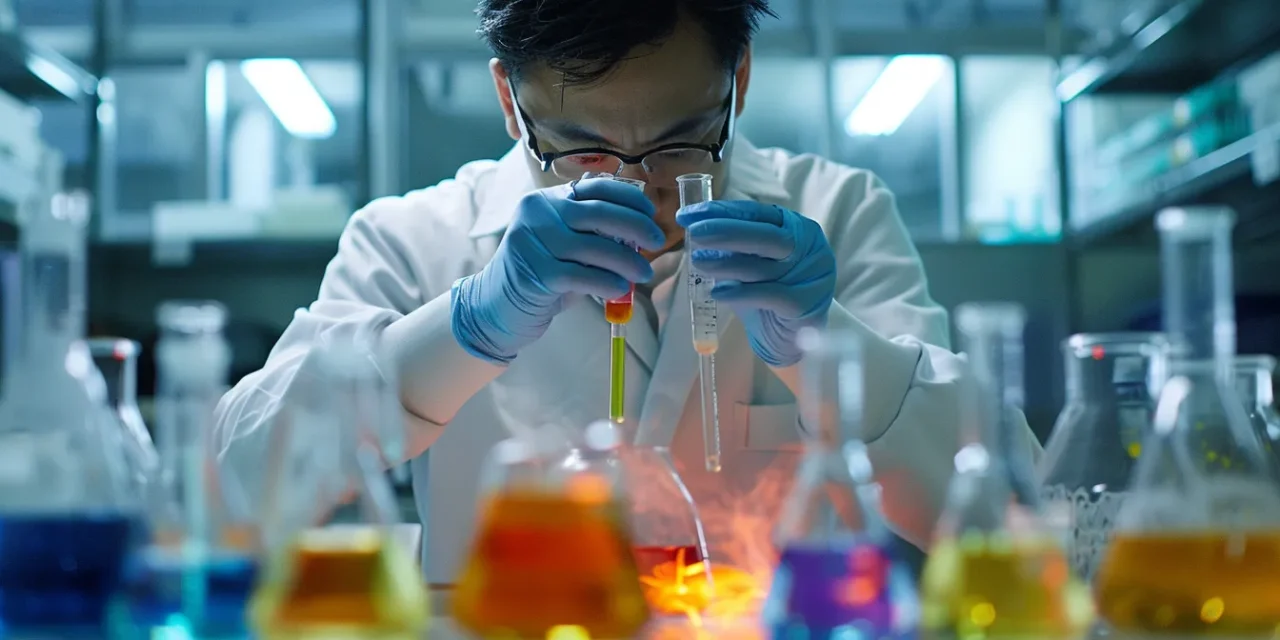Table of Contents
ToggleEssentials of Chemical Process Engineering
As a chemical engineer, are you striving to streamline your processes and enhance product quality while adhering to safety and environmental regulations? This article dissects the essentials of chemical process engineering, guiding you through the intricate balance of chemistry and physics at work within every chemical substance and engine. We will delve into the core areas of designing efficient processes, mastering reaction engineering, and the pivotal role of process control in optimization. You will discover how these practices not only solve production bottlenecks but also enhance safety and compliance standards. Join me as we navigate the complexities of this field and equip you with the knowledge to advance with current industry innovations.
Understanding the Fundamentals of Chemical Process Engineering

Grasping the fundamentals of chemical process engineering begins with becoming well-versed in core concepts and terminology. As a professional with a background in biological engineering, perhaps even holding a bachelor of science or a doctor of philosophy, I recognize the critical role of research in shaping our understanding. Chemical process engineers navigate complex systems, interweaving principles from biology and other sciences to develop and optimize processes. Upcoming sections will elucidate the diverse responsibilities of these engineers and the practical insights required for excellence in this field. My objective is to ensure that these insights impart tangible value, particularly for those embarking on or advancing in this career.
Comprehend Basic Concepts and Terminology
In my journey through a Master of Science in Chemical Engineering, I have learned that a robust grasp of basic concepts and terminology is indispensable. For instance, understanding the behavior of water in various processes, whether it’s for purification or as a reagent in production, is fundamental. This knowledge is not only scientific but also has significant implications on how these processes influence the natural environment, reinforcing our duty to engineer sustainably.
My experience with industries that rely on chemical processes, such as petroleum refinement, has taught me the value of precision in language. Clarity in communication — distinguishing between terms like “catalyst” and “reagent,” or “batch process” and “continuous process” – empowers professionals to optimize operations, reduce errors, and foster innovation while respecting ecological balances. This is a critical skill set I aim to share with fellow engineers striving to excel in this field.
Identify the Role of Chemical Process Engineers
My role as a chemical process engineer extends into the realms of biomedicine and technology, where meticulous design and operation of chemical processes are paramount. By utilizing principles of catalysis and process engineering, I devise solutions that bolster efficiency, cost-effectiveness, and safety in the production of pharmaceuticals. My education and expertise converge to ensure that these intricate biomedical manufacturing environments uphold the highest standards, thus directly impacting the quality and accessibility of medical treatments.
In the domain of process engineering, my responsibility encompasses the meticulous oversight of technological frameworks, ensuring they align with environmental guidelines while advancing operational excellence. Each decision I make, from selecting optimal catalysts to refining production methods, is driven by an educational foundation that emphasized sustainable practices. These choices not only reflect a commitment to producing superior outcomes but also serve to address and mitigate the environmental challenges our industry faces, guiding peers and stakeholders toward a harmonious balance between innovation and conservation.
Now we grasp the bedrock principles that underpin chemical process engineering. Let us march forward, delving into the art of sculpting efficient chemical processes.
Designing Efficient Chemical Processes

Designing efficient chemical processes stands at the heart of successful manufacturing systems. In my practice, I’ve seen firsthand how developing process flow diagrams and models serves as the blueprint for any chemical reaction’s path from raw materials to finished products. Applying material and energy balances is not just theory; it’s a necessity to optimize design, ensure operational efficiency, and maintain sustainability. These topics form the backbone of a process that caters to innovation, cost reduction, and environmental stewardship.
Develop Process Flow Diagrams and Models
In my practice within the field of chemical process engineering, the assembly of process flow diagrams and models has been integral to the manifestation of biotechnology and innovation. These models should proficiently serve as the mapping mechanism for every unit operation involved in manufacturing, emphasizing the management of heat and energy exchanges. Mapping these pathways allows for critical assessments that advance sustainability and cost efficiency while ensuring alignment with the rigorous mathematical frameworks governing these systems.
Through the development of these diagrams, I’ve enabled teams to visualize complex processes that underlie the creation of bio-products, simultaneously highlighting areas where improvements can be realized. By collating data on material flows, reaction sequences, and time constraints within these models, we have reinforced the foundation for innovation in chemical process engineering, leading to enhanced sustainability and efficiency of operations. The clarity and detail afforded by these tools are invaluable for strategic planning and continuous improvement in the ever-evolving landscape of process engineering.
Apply Material and Energy Balances in Design
In my practice as a chemical process engineer, applying principles of thermodynamics to maintain precise material and energy balances is indispensable. This approach ensures that each molecule participates as intended, contributing to the efficiency and sustainability of the process. My collaboration with experts from the American Institute of Chemical Engineers has consistently underscored the importance of this meticulous balance; it’s a core practice that leads to reduced waste and lower costs for production facilities.
During my professional experience, I’ve observed that integrating biochemistry and materials science into process design not only optimizes the utilization of energy and resources but also elevates the functionality and market readiness of the end product. By calculating energy inputs and outputs with precision, I have been able to streamline processes, which directly correlates to the longevity and profitability of operations in the chemical industry. This practical insight helps businesses to minimize their environmental footprint and adapt to the evolving demands of the market.
Designing efficient chemical processes lays the groundwork. Let us step forward, refining our craft in mastering chemical reaction engineering, where precision meets practice.
Mastering Chemical Reaction Engineering

In chemical process engineering, mastering the intricacies of reaction design is crucial. As a chemist and engineer, my role in understanding and executing chemical kinetics and various reactor types is pivotal in optimizing chemical plant operations. This section will delve into how I implement reaction mechanisms in process design, tackling the vital interplay between theory and practice. Whether it’s refining fuel methodologies or integrating biomedical engineering applications, these components are fundamental in engineering efficient and innovative chemical processes. The next detailed discussions will illuminate the practical applications of these topics, underscoring their indispensable value in the field.
Analyze Chemical Kinetics and Reactor Types
In tackling the complexity of chemical reaction engineering, I harness my expertise to analyze chemical kinetics, which is the study of reaction rates and mechanisms. This proficiency is vital when designing reactors, as it dictates optimal conditions for polymerization processes that are pivotal in manufacturing products integral to health and information sectors. My practical experience indicates that understanding how molecules react and transform, under various conditions, informs the selection of suitable reactor types – be it batch, continuous-stirred, or plug-flow – to enhance process efficiency and product quality.
Furthermore, I give attention to transport phenomena, a foundational element in chemical reaction engineering, which examines how momentum, heat, and mass move through systems. My hands-on experience in integrating this knowledge into process design has elevated the accessibility and functionality of high-value chemicals. For professionals aiming to innovate within the chemical industry, recognizing the interplay between kinetics and reactor types, balanced with transport phenomena, is not just beneficial – it’s essential for upholding the exacting standards that ensure safety, environmental compliance, and competitive edge.
Implement Reaction Mechanisms in Process Design
During my internship, I acquired hands-on knowledge that reinforced the importance of integrating complex reaction mechanisms into process design, a skill that I’ve continually refined since my days as an engineering bachelor. Implementing detailed reaction pathways into the design phase is crucial; it can lead to the development of groundbreaking applications in fields like nanotechnology, a sector where precision and scalability are paramount. My approach not only streamlines the manufacturing process but also paves the way for graduates entering the industry to understand the practical impact of their work.
In my journey from an undergraduate engineering bachelor to graduate school, I’ve consistently applied my expanding knowledge to tailor reaction mechanisms for optimal outcomes. This practice is vital in the fluid journey from small-scale laboratory settings to full industrial production, where the theoretical understanding of reaction dynamics becomes the bedrock of innovation and efficiency. My experience has shown that this translates to improved yields, reduced waste, and tangible progress in sustainable engineering practices—outcomes that are beneficial not only to businesses but also to the wider community they serve.
Mastering chemical reaction engineering sets a firm foundation. With this knowledge, we march forward to the next challenge: refining the artfulness in process control and optimization.
Implementing Process Control and Optimization

Turning our attention now to the core aspects of chemical process engineering, I anchor this discussion on two pivotal aspects: the utilization of control systems for process stability and the relentless pursuit of process optimization for enhanced performance. Whether these practices are utilized in the chemical industry or taught in graduate programs at universities, they are foundational for ensuring consistent, high-quality results. This next section goes into the detail on how undergraduates, graduates, and experienced practitioners alike can apply these principles to elevate the efficacity and reliability of our operations. Simple yet impactful, the content that follows offers practical insights pivotal for those embarking on their professional journeys or seeking to refine their existing methodologies.
Utilize Control Systems for Process Stability
During my presentation at the AIChE Annual Meeting, I spotlighted how robust control systems are paramount for process stability within chemical process engineering. My shared experiences in the laboratory have convinced me that integrating advanced control systems can mitigate the complex interplay of variables in process transport, preventing deviations that lead to inefficiency or safety concerns. These systems, informed by Master of Engineering practices, enable precise manipulation of parameters, ensuring steady operation even in the face of unexpected fluctuations.
In my role, aligning with ABET accreditation standards, I consistently reinforce the deployment of such systems in academic and industrial laboratories. Mastery in utilizing control systems is critical for maintaining the consistency and quality of outputs. As I’ve applied this knowledge to my work, it’s become clear that this aspect is non-negotiable for engineers seeking to optimize processes – it’s the cornerstone of an operation’s reliability and the mark of a true professional in the field of chemical process engineering.
Optimize Processes for Enhanced Performance
In my career as a chemical process engineer, I’ve realized that integrating interdisciplinarity is key to enhancing performance in this domain. Combining knowledge from analytical chemistry, computer science, and mass transfer, for instance, allows for a multifaceted approach to process optimization. This synergy not only improves the efficacy of chemical processes but also boosts the employment profile of engineers, enhancing their capability to address and resolve multifarious challenges.
Applying my expertise in computer science, I have been able to revamp traditional approaches, leveraging computational tools for process simulation and optimization. My proactive implementation of these technologies has led to noteworthy improvements in process efficiency, bolstering mass transfer, and ultimately contributing to the operational excellence of chemical plants. The advancements in this area are a testament to the power of leveraging cross-disciplinary skills in driving innovation and ensuring sustained performance improvements.
With process control refined, we turn our attention to safety, the backbone of sustainable operations. It is here we marry precision with responsibility, ensuring every action respects both human life and the environment.
Ensuring Safety and Environmental Compliance

As I delve into the essentials of chemical process engineering, I consider the implementation of safety protocols and the stringent adherence to standards non-negotiable in fostering a secure work environment. Central to my methodology is addressing the environmental impact of our procedures, emphasizing sustainability. Hydrogen production, a burgeoning area within renewable energy, often involves delicate chemical reaction engineering where safety overlaps significantly with mechanical engineering principles. Upcoming discussions will shed light on the pertinence of these practices, and the inventive strides we make within the industry.
Implement Safety Protocols and Standards
In my tenure as a professor, I’ve emphasized to my students the vital importance of integrating mass and energy considerations into safety protocols. The application of computational chemistry to predict potential hazardous interactions has been pivotal in advancing our methodology. I’ve witnessed firsthand how this approach has significantly mitigated risks, optimizing safety measures while conserving mass and electricity – a dual benefit enhancing both safety and operational efficiency.
Moreover, effective communication of safety standards remains a cornerstone of process engineering. In my collaborations, the clarity with which these standards are conveyed directly impacts the adherence and execution of safety measures. Streamlining communication channels has proven effective in fostering a culture of safety that values the preservation of both human life and the environment, an outcome that I constantly strive to deliver in my profession.
Address Environmental Impact and Sustainability
In my capacity as a chemical process engineer, I have witnessed how engineering education evolves to emphasize the creation of biomaterials that present sustainable alternatives to conventional oil-based products. Institutions like the Massachusetts Institute of Technology spearhead this approach, preparing graduates to not only meet technological demands but also to innovate with an acute awareness of their environmental footprint. My work often involves collaborating with industry experts to integrate eco-friendly materials into processes, striving to delineate a path towards greener and more sustainable practices in chemical engineering.
My engagement with the Institution of Chemical Engineers has further underscored the essential blend of theoretical knowledge and practical application in addressing environmental impacts. By harnessing my expertise in process engineering, I have contributed to the development and implementation of cleaner production technologies that substantially decrease harmful emissions. These actionable insights illuminate the path forward for fellow engineers and stakeholders, illustrating that a commitment to sustainability can coexist with industrial progress and innovation.
Our vigilance on safety and environmental protocols sets a firm groundwork. Let’s turn our focus to the horizon, where industry innovations and current trends steer the future.
Advancing With Industry Innovations and Trends

In my quest to remain at the forefront of chemical process engineering, I understand the importance of continuous learning and embracing new advancements. Emerging technologies, from innovative membrane processes within oil refineries to novel cell cultures in biomanufacturing, are reshaping the landscape of our industry. Participation in professional development opportunities is not only beneficial but essential for any engineer passionate about integrating the latest trends from colleges and leading-edge manufacturing engineering firms. I will delve into these areas to demonstrate how staying informed and educated can significantly elevate our work.
Stay Informed on Emerging Technologies
Remaining abreast of emerging technologies is a commitment I take seriously in my chemical process engineering career. I’ve engaged with the latest computer simulation tools, which revolutionized my approach to modeling electrochemical processes, increasing precision in industries ranging from mining to medicine. My affiliation with the American Chemical Society has been invaluable, as it provides access to a rich reservoir of resources that keeps me informed about state-of-the-art advancements and cross-disciplinary applications within chemical engineering.
I’ve observed that implementing cutting-edge electrochemistry techniques greatly enhanced the efficiency of metal recovery in mining operations, underscoring the pivotal role of staying current. This firsthand experience reinforces the need to understand and utilize such advancements, as they provide a competitive edge while bolstering sustainability and efficiency. Moreover, knowledge sharing within professional networks, like the American Chemical Society, elevates our collective expertise and fosters a culture of continual learning and innovation.
Participate in Professional Development Opportunities
Throughout my career, I have observed the transformative impact of professional development opportunities, particularly in the multifaceted sectors of environmental engineering and the chemical industry. Attending specialized workshops has deepened my understanding of emerging plastic recycling technologies, leading to significant advancements within the automotive industry where material sustainability is increasingly prioritized. My pursuit of a doctorate also exemplified the value of such opportunities for professional growth, enabling me to contribute novel research to our field.
In my engagements with industry experts, I’ve also advocated for continuous learning as a gateway to innovation, urging professionals to attend conferences and seminars that highlight cutting-edge techniques in chemical process engineering. The cross-pollination of expertise from these events has enhanced my efforts in designing processes that consider ecological integrity, thereby reinforcing the bridge between chemical industry practices and environmental engineering.
Frequently Asked Questions
What are the core principles of chemical process engineering?
Chemical process engineering revolves around the design, operation, control, and optimization of chemical processes, integrating principles from chemistry, physics, and engineering to transform raw materials into valuable products.
How do I design an efficient chemical process?
Designing an efficient chemical process requires meticulous planning, including the selection of optimal reactants, energy-efficient operations, precise control systems, and integrating scalable processes that ensure safety and environmental compliance.
What is involved in mastering chemical reaction engineering?
Mastering chemical reaction engineering requires a thorough understanding of reaction kinetics, reactor design, thermodynamics, and process optimization to innovate and improve industrial reactions.
Can you explain process control and optimization techniques?
Process control and optimization entail monitoring system performance, adjusting process variables, and employing algorithms to enhance efficiency, reduce waste, and maintain product quality within industrial operations.
What measures ensure safety and environmental compliance in chemical engineering?
In chemical engineering, rigorous process safety management, adherence to environmental regulations, and regular risk assessments are pivotal to ensuring operational safety and compliance with environmental standards.










